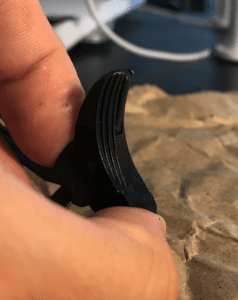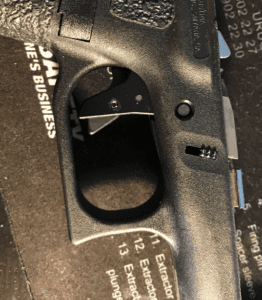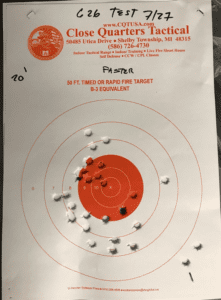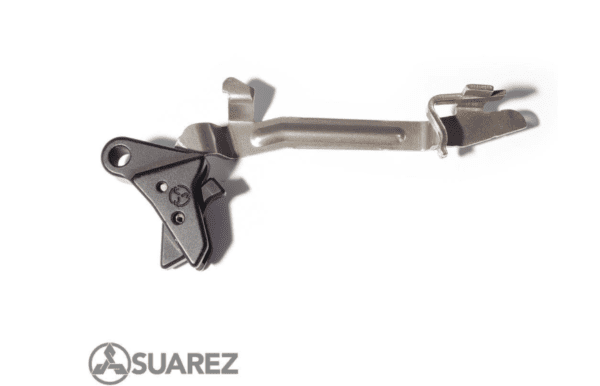Even the most die-hard GLOCK fanboy has to/should/must admit that Gaston’s motto of “perfection” doesn’t include the triggers in his guns. That said, arguably, the standard-issue GLOCK gas-pedal is one of the better triggers in the striker-fired cohort, if not the best. Though there’s a long take-up, the break is reasonably crisp, and there’s plenty of tactile feedback on the reset. The problem: Austria’s famous export is a compromise between too many competing interests.
GLOCK’s “Safe Action” triggers are a compromise between the need for a clean break for combat accuracy, accommodation of the manually-toggled bladed trigger safety and the need to earn “import points” from the ATF, which led to the choice of a serrated trigger face for its compact-sized (GLOCK 19) and smaller handguns. As a result, the trigger doesn’t excel in any area.

Personally, I find the tactile break and reset to be good enough for minute-of-torso accuracy under pressure. My bone of contention has always been the GLOCK’s trigger safety blade.
For extended range sessions or multi-day training courses, the trigger safety protrudes just slightly out from the trigger face. Even when fully depressed. Even when using the “smooth” trigger which comes stock with the full-sized GLOCKs (and which can be dropped in with minimal effort in the others.)
It causes me no end of discomfort after an extended period of time. My trigger finger had a hot spot on it after just two days on the range in Florida recently; a week long class leaves it taped up entirely. Not optimal.
You can’t swing a bat nowadays without hitting someone who’s selling aftermarket parts for GLOCKs; finding quality products that actually improve the situation is the difficulty. Feedback from some friends who had been there, done that, pointed me in the direction of Suarez International (SI), the company founded by firearms trainer (and so much more) Gabe Suarez.
SI manufactures GLOCK replacement triggers that are flat, with a wide trigger safety bar that goes flush with the trigger itself. It’s called, appropriately enough, the Flat and Straight Patrol Grade Trigger.
Many shootists swear by flat triggers; they enable more consistent finger placement and improve leverage. All of which (hopefully) helps with accuracy. The fact that SI’s trigger safety blade is wider than the standard blade and retracts to flush helps with comfort, too. As SI’s triggers are drop-in replacements priced at $59.99 (about half the going rate for other aftermarket triggers), I decided to throw some money at Gabe and give his GLOCK trigger a try.
SI offers two different flavors of flat trigger: the Patrol Grade and the Tactical Grade. The Patrol Grade — reviewed here — matches up a flat SI trigger with an OEM trigger bar. In other words: the only thing that’s changed is the trigger itself.
GLOCK 42 and 43 triggers ship with the appropriate OEM bar. Double-stack GLOCK triggers ship with an OEM Gen 3 trigger bar — which is completely compatible with the Gen 4 GLOCKs as well.
[NOTE: There’s griping amongst some Gen 4 users that the Gen 3 trigger bar makes things a little less crisp, but this author has used Gen 3 triggers for nigh ten years now, so this was no skin off my nose. Your mileage may vary. Also, the single-stack .45 ACP GLOCK 36 has a unique trigger bar that’s not compatible with any of the above.]
SI’s Tactical Grade trigger is a different animal; it mates the flat & straight trigger with a proprietary SI assembly that endeavors to reduce trigger travel and make the break more crisp. Like many “make your GLOCK trigger just like a 1911” packages, there have been complaints that this trigger packages disables the drop safety of the pistol. SI has a disclaimer on its website stating flatly that the Tactical Grade Trigger “is not a trigger for a novice.”
This author isn’t a big fan of reducing the trigger weight of the GLOCK. I’m accustomed to the stock trigger; and with an ever-growing stable of GLOCKs at home, I like to keep things consistent. Drop safety issues aside, this also was sufficient reason to choose the Patrol trigger over the Tactical.
Installation
SI officially recommends that the trigger be installed by a competent gunsmith; in this case, two triggers were installed — one into a GLOCK 43, the other into a Gen 4 GLOCK 26, fresh off the shelf from Pointe Trap & Tactical in St. Clair Shores, Michigan. The author himself played the role of ‘competent gunsmith’.
Replacing the GLOCK trigger/bar assembly is a simple task described ubiquitously on the Internets that anyone who can successfully change the tires on a car without injury or damage can learn and accomplish. It simply requires the user to detail-strip the GLOCK receiver, switch out the trigger / bar and re-assemble, which can be done in under ten minutes. (Note: the process for installing the trigger in the single stack GLOCK 42 and 43 is slightly different vs. their double-stack cousins; The process is described here.)
Installation went without issues on the GLOCK 26. On the 43, the install went fine, but when I went to put the slide back on, the trigger bar was hanging put a bit on the slide. It went on, but required a bit more force than it did with the (by this point well broken-in) original bar. As I recalled, however, the original bar had this ‘issue’ at the beginning too, and after a quick call to a rather friendly SI gunsmith just to confirm that this wasn’t a sign of an actual issue, I decided to proceed with testing.

Testing
Whenever a carry pistol gets a significant modification, it needs to be tested to establish its reliability; in the case of the G26, the test would be to establish reliability, generally, as this was the first time the pistol had been fired by me. Three hundred rounds were sent downrange in both the 26 and the 43. American Eagle 147-grain flat nosed rounds were used in the 43, while the 26 received Inceptor 65-grain copper/polymer “sport utility ammo”. Targets ranged from 15′ – 25′ in distance, at the Close Quarters Tactical indoor range in Shelby Township, Michigan.
There were no issues encountered in either pistol. Accuracy appeared to be consistent with results obtained prior to the modification in the GLOCK 43. (No pre-test results were available for the 26, as it was brand-new.)

Trigger weight was unchanged from stock, clocking in consistently at around 5 lbs on the G43 and a little above 4 lbs on the G26, according to a Timney Triggers scale.
Subjectively, the trigger felt nice on both guns.
On the GLOCK 43, the trigger was just as crisp as it had been before, but without the safety blade digging into my finger, and with (I believe) consistent finger positioning. A step up all around.
On the GLOCK 26, the trigger was very comfortable. The use of the Gen 3 trigger bar, however, resulted in a bit more sponginess at the break versus stock that even I noticed, despite being generally accustomed to Gen 3 triggers. If I could get this trigger with a Gen 4 bar, this would be ideal. As it is, I will likely leave it on since I feel that it is a net improvement, just be aware that with the Gen 4, this mod isn’t an unalloyed advance in every regard.
Since the issue of drop safety is in the air, the procedure for checking the drop safety outlined by Overwatch Precision’s You Tube video was followed, just to be safe. As expected, the drop safety appeared to work as intended (as it should since, of course, it’s a GLOCK trigger bar with the package.)
Materials and Quality
The trigger itself is made of plastic, just as the OEM one is. There’s a small Suarez International “triquetera” logo etched on the side, barely noticeable unless you’re looking hard.
The Verdict
Is it worth the money? If you’re dissatisfied with the feel of the bladed safety on the GLOCK trigger, but aren’t looking to change the weight or risk disabling the drop safety, then yes, this is a good one to try. It’s inexpensive, the leverage provided by the flat trigger makes the break feel lighter, the flush blade safety makes the whole thing more comfortable and easier to get a consistent position of the finger, and the use of the OEM GLOCK trigger bar means that there’s no change to the weight of the trigger itself.
Double-stack GLOCK’ers who feel that the Gen 4 trigger beats the pants off of the Gen 3’s, however, should note that at this time, SI only supplies its Patrol-grade trigger assemblies with a Gen 3 bar. If that’s a dealbreaker for you, be warned. The Gen 3-ish sponginess isn’t enough of a dealbreaker for me with my Gen 4 GLOCK 26 — the comfort and finger placement consistency is good enough for me. That said, it would be nice if this trigger could be had with a stock Gen 4 bar.
Ratings (out of five stars):
Installation * * * * *
Suarez officially recommends that a “competent gunsmith” do the installation, but this goes in just like any other GLOCK brand GLOCK trigger, and experienced GLOCKers can do the install in a few minutes. It ships with an OEM (Gen 3) trigger bar, compatible with Gen 4 GLOCKs. (No word on compatibility with Gen 5 GLOCKs at the time of writing.)
Function * * * * *
Archimedes was right: with a long enough lever, you can move the world. The weight didn’t change an ounce, but it sure felt lighter, crisper than before. The flat, wide trigger makes it easy to get the finger right where it needs to be. An hour and 300+ trigger presses per firearm and my trigger finger felt just fine.
Fit, Finish & Build Quality * * * * 1/2
The trigger itself is made of plastic that comes in one color: black. I suppose it could’ve been made of metal for a higher-quality look and feel, but that likely would’ve increased the price point. It does have the Suarez International logo etched on the side, but it is rather unobtrusive. The trigger bar itself is, of course, an OEM Gen 3 trigger bar, so it comes with whatever quality GLOCK bakes into its components.
Value * * * * *
At $59.99 plus shipping, this is the cheapest aftermarket trigger available for GLOCKs at the moment; the others range above $100. (The GLOCK OEM smooth-faced trigger is around $15, and is also a drop-in install, but that didn’t solve the author’s issue with the protruding trigger safety blade the way the SI Patrol Trigger did.)
Overall * * * * *
If you’re looking for a better-feeling trigger, but want to keep a stock trigger bar, this is a good one to get. My wife has already asked for one on her own GLOCK 19, too, and I still have two other GLOCKs that might be in for a replacement when I get around to it.





I had to re read that statement about glock having the best stock trigger on a polymer pistol a few times
Agreed. He lost all credibility with that statement. The PPQ, VP9, M&P 2.0, P320, FNS, and Canik are all widely regarded as having better triggers. From the examples I’ve shot I’d have to agree.
Actually, I said “arguably” it was one of the “better” triggers, not the best (note the link to a pistol review about a striker-fired gun with what is supposedly a 1911-esque trigger.)
That said, I wasn’t impressed with the trigger on the S&W or the PPQ. Have not tried the others. YMMV.
I have a CZ P-10C and a Grand Power Q100. They both feel pretty darn good compared to the stock Glock. Although I would never turn down a Glock and I am building one from a polymer 80 for fun.
The PPQ is MILES ahead of the Glock. The VP9 is a pretty close second.
The P320 starts out meh but gets better. The M&P 2.0 is quite good.
The stock Glock trigger gets the job done, but it’s not near the top of the striker-fired heap.
Reading is fundamental. He did not say it has the best striker fired trigger, “arguably” one of the “better.”
What the fuck is “patrol grade” ? Who is making this stuff up? Really.
Its Suarez’s marketing BS. It really means that its crappy but we are going to sell it anyways.
After seeing several horrible training practices of his I will never spend a penny with Suarez
Is “Patrol” the new “Tactical” or is it “Operator (minus)”?
If its Suarez, it a minus
“Operator minus” love it…or possibly, Mil-spec lite? That is so Tufnel of them…
think “crossing guard.”
“Patrol Grade” means it’s appropriate for a gun carried on duty/patrol by officers, as opposed to “Tactical Grade” which is superior in performance but would not be approved for such use.
Because, who wants superior performance in a trigger? Patrol must also equate to dumb as shit…also, i’m pretty sure thats NOT how it works as I’ve sold PLENTY of ARs for use as “patrol rifles” and they all had a mil-spec trigger (Stag arms or Windham Weaponry). I’m sure they met department requirements.
I’ve heard of Mil-Spec, but never “Tactical Grade”. What store in the mall sells that??
I’m a bit confused as to what point you are trying to make. The idea is to improve on the stock trigger while still meeting department requirements. The Tactical trigger in a duty weapon would be like using a competition trigger in a duty AR. It may help you shoot the best possible but the department would probably not approve it due to all the things they worry about.
My point is that people are now making up words for marketing that are pure crap. I’ve been in this industry for years and all the trade mags, all the dealer adverts and even the SHOT show I don’t ever recall “patrol” or “Tactical” grade anything. I also know that some internal parts polishing will get you pretty much the same effect for free…except for that flat trigger that screams “Hey everybody, I am cool. I upgraded my trigger.”
It’s not an “install”.
It’s an installation. Gun readers do notice dopey language; it seems that gun articles are the last articles in America that don’t dumb everything down to the English level of a three-year-old. TTAG is great. Let’s keep it that way.
If that’s the worst sin I’ve committed this year, I’m doing pretty well.
The stock trigger works just fine. Most of them do. They are all slightly different. Get used to whatever you have to work with, and stop bitching about their smoothness and reset qualities. It doesn’t matter. It only matters when you are standing in the range booth, maintaining a steady 55 beats a minute, on a weekend afternoon with a buddy or two, trying out a new toy at the beginning of your bar hopping tour.
I’ve never understood the gripe about the trigger safety blade. I went through a PD firearms instructor school with 9 other people where we put 500 rounds a day for a week through the Glock 22 and nobody had any complaints about the trigger blade. My thumbs were swollen from loading so many freaking magazines but the trigger blade was a non issue.
Suarez just copies others stuff. When he first launched his glock trigger it would go bang if you dropped it or hit it on the back due to it being to have no pre travel. his excuse was I don’t drop my guns so why would I test it, they finally fixed it by leaving small pretravel and shaving some off the plunger safety angle.
I like how he lowered his price. I do enjoy the feel of the tactical once you get it dialed in
You lost me at “Glock”.
I gave Glocks a fair shake over the years. I have owned three. But I always kept selling them off. I could never get used to how they point, and even with “advanced” triggers, they cannot beat a good DA/SA in SA mode. And no, the Glock triggers are not the best striker fired triggers on the market, and I don’t see the point in spending over $500 for a gun with a crappy trigger.
I have the tactical version of this trigger. It has a shorter pre travel. I really like the flat face. It helps your finger pull straight back because you have the flat surface as a reference. Matched with a Ghost trigger bar the pull is excellent.
Daily reminder that Gabe Suarez defrauded the PD he worked for, is an admitted schizophrenic, and hires “trainers” who put bullet holes into clients’ vehicles.
Are you sure you aren’t confusing him with Yeager?
Both are posers. I wouldn’t give a convicted felon like Suarez a dime.
I ordered one of the flat face shooter triggers based on this article. Poor decision. The website is narcassitic at best and should have been a red flag! “We dont need your business…”
The trigger, when installed created a gritty, creepy, mess of an otherwise ‘decent’ trigger. The shoe shape is great but the finished product is garbage. I run Zev and Apex and this is by far subpar for an after market, tactical “genius”.
The ‘customer service’ is a joke. It must be installed by a gunsmith, it must not have been installed to be returned, it must not be worn or damaged… but it cant have been installed.
The rep even went so far as to suggest having a gunsmith install this on the original trigger bar. Why buy a drop in trigger assembly if I need to use my original bar to get a decent trigger pull?
I have upgraded several Glock triggers from stock to Apex. They are easy to install, drop in. Trigger bar looks stock but polished. The pre-travel is short with a definite break, short, tactile reset, again, crisp break. You can purchase for under $100. With this upgrade, your Glock trigger will compare favorably with others mentioned here. I have the Canik, VP-9 (also SK), and the P-10c, and there is no huge difference in any of them. They each have unique feel, but are all excellent.